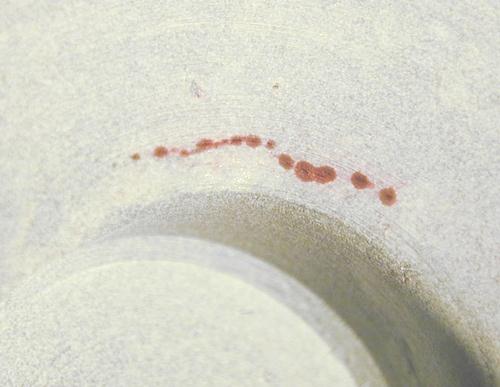关于磁粉检测及渗透检测等相关知识问答
液体渗透检测能检测什么?
液体渗透检测(PT)是一种无损检测,它可以检测表面断裂缺陷,如细线裂纹、表面孔隙率、新产品泄漏和疲劳裂纹等。 它可以利用液体染料将不可见的缺陷变为可见的缺陷。
What can be detected by liquid penetrant test?
Liquid penetrant testing (PT) is a one of non-destructive test, which can detect surface-breaking defects-such as hairline cracks, surface porosity, leaks in new products, and fatigue cracks. It can change invisible defects to visible defect by using liquid dye.

磁粉检测是什么?
磁粉检测 (MPT),也称为磁粉检测(MPI),是一种无损检测 (NDE) 技术,用于检测大多数铁磁材料(如铁、镍和钴以及它们的一些合金)的表面和轻微亚表面缺陷。
What does magnetic particle testing detect?
Magnetic Particle Testing (MPT), also referred to as Magnetic Particle Inspection, is a nondestructive examination (NDE) technique used to detect surface and slightly subsurface flaws in most ferromagnetic materials such as iron, nickel, and cobalt, and some of their alloys.

渗透系统的四种方法是什么?
通过从零件中去除多余渗透剂的方法对渗透剂进行分类。下面列出了四种方法:
方法 A - 可水洗
方法 B - 乳化,亲脂性
方法 C - 可去除溶剂
方法 D - 乳化,亲水性
可水洗(方法 A)渗透剂可以通过单独用水冲洗从零件中去除。 这些渗透剂含有一种乳化剂(去污剂),可以单独用水从零件表面清洗渗透剂。 水洗渗透剂有时被称为自乳化系统。 乳化后渗透剂有两种,亲油性和亲水性。 在乳化后亲油体系(方法 B)中,渗透剂是油溶性的,并与油基乳化剂相互作用,从而使去除成为可能。 乳化后亲水系统(方法 D)使用乳化剂,它是一种水溶性清洁剂,可通过水洗将多余的渗透剂从零件表面去除。 溶剂去除渗透剂(方法 C)需要使用溶剂从部件上去除渗透剂。
What are the 4 methods of penetrant systems?
Penetrants are then classified by the method used to remove the excess penetrant from the part. The four methods are listed below:
Method A - Water Washable
Method B - Post-Emulsifiable, Lipophilic
Method C - Solvent Removable
Method D - Post-Emulsifiable, Hydrophilic
Water washable (Method A) penetrants can be removed from the part by rinsing with water alone. These penetrants contain an emulsifying agent (detergent) that makes it possible to wash the penetrant from the part surface with water alone. Water washable penetrants are sometimes referred to as self-emulsifying systems. Post-emulsifiable penetrants come in two varieties, lipophilic and hydrophilic. In post-emulsifiers, lipophilic systems (Method B), the penetrant is oil soluble and interacts with the oil-based emulsifier to make removal possible. Post-emulsifiable, hydrophilic systems (Method D), use an emulsifier that is a water soluble detergent which lifts the excess penetrant from the surface of the part with a water wash. Solvent removable (Method C) penetrants require the use of a solvent to remove the penetrant from the part.
渗透剂有多少种类型?
三种基本类型的渗透剂: 颜色对比,荧光,双重目的(荧光/颜色对比)
How many types of penetrant are there?
three basic types of penetrant: Colour contrast. Fluorescent. Dual purpose (fluorescent / colour contrast)
哪种类型的渗透剂最敏感?
荧光渗透剂本质上比颜色对比度更敏感。 后乳化剂比水洗剂更敏感,因为渗透剂过度洗涤的危险较小。 非水显影剂是最敏感的。
Which type of penetrant is most sensitive?
Fluorescent penetrant is inherently more sensitive than colour contrast. Post-emulsifiable is more sensitive than water washable since there is less danger of over-washing of the penetrant. Non-aqueous developer is the most sensitive.
渗透测试的基本步骤是什么?
在染料渗透测试中,检验人员一般遵循以下六个步骤:
• 清洁表面
• 涂抹染料渗透剂
• 去除多余的渗透剂并涂抹去除剂
• 使用显影剂
• 检查
• 清洁表面。
What are basic steps in penetrant testing?
In dye penetrant testing, inspectors generally follow these six steps:
• Clean the surface
• Apply the dye penetrant
• Remove extra penetrant and apply remover
• Apply developer
• Inspection
• Clean the surface
液体渗透试验的缺点是什么?
液体渗透测试有以下缺点: 广泛、耗时的预清洁至关重要——表面污染物会掩盖缺陷。 仅对表面断裂缺陷敏感。 需要直接连接到被测表面。
What is disadvantage of liquid penetrant test?
Liquid penetrant testing has the following disadvantages: Extensive, time-taking pre-cleaning critical—surface contaminants can mask defects. Sensitive to surface-breaking defects only. Direct connection to the surface under test necessary.
磁粉探伤MPI的原理是什么?
该方法的原理是样品被磁化以在材料中产生磁力线或磁通量。 如果这些力线遇到不连续性,例如裂缝,则在裂缝的表面会产生二次磁极。
What is the principle of magnetic particle inspection MPI?
The principle of the method is that the specimen is magnetised to produce magnetic lines of force, or flux, in the material. If these lines of force meet a discontinuity, such as a crack, secondary magnetic poles are created at the faces of the crack.
磁粉探伤有几种类型?
有两种不同的铁磁检查介质:干粒子和湿粒子。 两种形式都可以是荧光或非荧光(可见,颜色对比),并有多种颜色与测试材料形成对比。
How many types of magnetic particle inspection are there?
There are two different ferromagnetic examination media: dry particles and wet particles. Both forms can be either fluorescent or non-fluorescent (visible, color contrast) and come in a variety of colors to contrast with the tested material.
磁粉探伤有哪些局限?
无损检测磁粉法的缺点是: 它仅限于铁磁材料——通常是铁和钢,不能用于奥氏体不锈钢。 很麻烦。 大多数方法都需要供电。
What are the limitations of magnetic particle inspection?
Disadvantages of the Magnetic Particle method of Non-Destructive Examination are: It is restricted to ferromagnetic materials - usually iron and steel, and cannot be used on austenitic stainless steel. It is messy. Most methods need a supply of electricity.
可以在涂漆表面上进行MPI吗?
根据 ASTM E709-15,“薄的非导电涂层,例如 1 或 2 mil(0.02 至 0.05 毫米)的油漆,通常不会干扰指示的形成,但为了形成直接磁化必须在所有电接触点去除非导电涂层。”
Can MPI be done on painted surface?
According to ASTM E709-15, “Thin nonconductive coatings, such as paint in the order of 1 or 2 mil (0.02 to 0.05 mm) will not normally interfere with the formation of indications, but they must be removed at all points where electrical contact is to be made for direct magnetization.”
染料渗透剂和磁粉检测有什么区别?
MPI 能够通过薄涂层检测缺陷。 染料渗透剂对不良表面条件的耐受性较差,其有效性也会受到缺陷内任何材料的不利影响。 此外,MPI 的应用比染料渗透剂快得多。
What is the difference between dye penetrant and magnetic particle testing?
MPI has the capability to detect defects through thin coatings. Dye penetrant is less tolerant of poor surface condition and its effectiveness can also be adversely affected by any material within a defect. In addition MPI is much quicker to apply than dye penetrant.
下一篇:关于冲击和振动环境下编码器的选择


